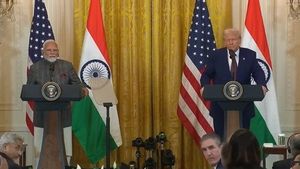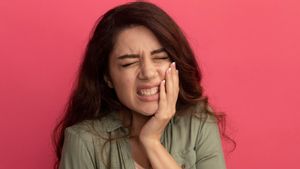Law Number 35 of 2009 concerning Narcotics is a problem that this country denies. Not only in relation to the use of marijuana. The article "The Origin of the Narcotics Law in Indonesia and the Myriad Problems Behind It" has explained how this law is far from being effective in eradicating narcotics. Part of VOI's signature Series, "Don't Panic It's Organic". This time we see how closely Indonesian people live with marijuana, from generation to generation. That the cannabis culture of the archipelago is not a myth.
Fidelis Arie Sudewarto was unable to do much when officers from the National Narcotics Agency (BNN) of Sanggau Regency, West Kalimantan arrested him on February 19, 2017.From Fidelis, BNN confiscated 39 cannabis trees he planted as a treatment for his wife, Yeni Riawati, who suffers from syringomyelia. Since then, Fidelis' efforts to care for Yeni have stopped. A few weeks after the arrest, March 25, 2017, Yeni passed away.
Efforts to treat Yeni with marijuana extract have been carried out by Fidelis since late 2016. And since then, Yeni's condition has continued to improve. Before being treated with marijuana, Yeni's condition was alarming. Difficulty sleeping, obviously. Apart from that, Yeni also had problems with bowel movements that caused her stomach to grow bigger. "The urine that was issued was also mixed with thick blackish blood," said Yohana La Suyati, Fidelis' older brother, written by Kompas.com, Tuesday, April 4, 2017.
Apart from that, Yeni also had difficulty eating. Whatever food is swallowed, it will be regurgitated not long after. In addition, Yeni also suffered wounds on the middle back of the waist. The wound was deep enough to reveal Yeni's bone. The wound was getting worse and wider. Yeni's wound was tremendous. He often screamed in pain. Not only that, Yeni's left hand and two legs were immovable.
Marijuana changes that. Since being treated with cannabis extract, Yeni has fallen asleep. In addition, Yeni's appetite has increased. He no longer vomits up his food. Yeni's digestion has also improved. Urinate or defecate smoothly again. Even more miraculously, the holes in Yeni's wounds closed with the growth of new flesh on Yeni's body. Since the marijuana treatment, Yeni has begun to communicate again and even sing.
"The pressure wound on the back of the waist is very large, about one adult's fist, whose bone is visible, it can close again and the surface is dry," said Yohana.
Yeni lost Fidelis, the only most reliable nurse. Yeni is also missing marijuana, a medication that helps her body work more optimally to fight fluid-filled cysts (syrinx) in her spinal cord. "Only Fidelis knows how to take care of his wife so that when he was detained, our family also couldn't do much. Because all this time he had done everything himself, including regulating the temperature in the room," said Yohana.
The culture of using marijuana for true health has been done since time immemorial. In Aceh, some people even still use marijuana root decoction as a treatment for diabetes. This story was told by Dhira Narayana, Chairman of the Indonesian Cannabis Circle (LGN). Based on the results of field observations and long research on literature related to the use of medical marijuana, LGN has also proposed a research collaboration to the Ministry of Health (Kemenkes).
Unfortunately, since it was proposed many years ago, the research has not been running. The National Narcotics Agency (BNN) that was most likely to provide marijuana for research refused to get involved. BNN adheres to Law Number 35 of 2009 concerning Narcotics, which states that marijuana as a class one narcotic cannot be used for anything, including medical. The National Narcotics Agency even has a different version, that marijuana is actually detrimental to health.
"Researchers have previously seen these adverse effects. The brain is rich in oxygen, if oxygen is exposed to marijuana, oxygen is bound by tetrahydrocannabinol or THC so it can cause calcification in brain cells so that the cells will die. How many dead cells will not be healthy again, only the rest can bind oxygen, "said the Head of the Narcotics Laboratory Center of BNN Mufti Djusnir in his statement.
I don't know which researcher is meant by BNN. What is clear, the food and drug regulatory agency of the United States (US), the Food and Drug Administration (FDA) has stated that the cannabidiol or CBD content in the cannabis plant can be used as a seizure medication due to epilepsy. Quoting CNN Indonesia writing which launched HowStuffWorks, Joshua Kaplan, a cannabis researcher from Western Washington University, called CBD a compound that is very much in tune with the work of the human body.
CBD works to activate serotonin receptors, which play an important role in treating anxiety. Interestingly, CBD is identical to endocannabinoid, a chemical compound that is naturally produced in the human brain. Endocannabinoids have a major influence in controlling a person's motor, cognition, emotions, and behavior. This means that everyone has "marijuana" in each of them. "The serotonin system plays an important role in treating anxiety," says Kaplan.
Indonesian marijuanaThe cannabis culture of the archipelago began when it was growing. In the past, the cannabis plant was fairly easy to find. Not only in Aceh and other areas in Sumatra, but also in Ambon, Jakarta (Batavia), to Bogor (Buitenzorg). This was revealed in the Ganja in Indonesia Fact sheet released by the Transnational Institute.
“It seems that, during the late 19th century, marijuana was still unknown among Javanese society. However, there is an assumption that the plant may have been cultivated on the island (Java), given the familiarity of the local community with terms such as marijuana, gandja, or gendji, ”he wrote.
Although marijuana cultivation in the Indonesian archipelago is not very popular, it is still grown in Ambon with seeds obtained from Java. Therefore, many people in Ambon and its surroundings use marijuana. One of them is by consuming marijuana root to treat gonorrhea.
Meanwhile, the leaves are sometimes mixed with nutmeg and brewed as a tea for the purpose of reducing asthma, pleuritic chest pain and bile secretion. In relation to cannabis and Indonesian culture, the book Herbarium Amboinense (1741) by the German-Dutch botanist, GE Rumphius can be used as a reference. He explained the community's familiarity with various marijuana preparations, both for recreational, medical and cooking spices.
Acehnese cultural observer, Tungang Iskandar, confirmed this. According to him, the people of Indonesia, especially Aceh, are familiar with the use of marijuana for generations. In addition, he said that the function of marijuana itself in the context of cooking is that it is useful so that meat becomes tender and tastes up food.
"I think it (the use of marijuana) is no longer a secret. Whereas, in practice, the Acehnese have been using it for a long time. In cooking, for example. "Marijuana seeds are often used in broth, including in broths that are cooked for special rituals in which every big man cooks," he said, when contacted by VOI, Monday, February 17.
Apart from being medical and food consumption, marijuana is also widely used in plantation activities. In many fields in various regions, hemp is grown among other crops as a deterrent. "If we talk about agricultural systems, cannabis plants, there are plants that are attractive to pests. So, for example, if we plant vegetables, plant water spinach, spinach, this is like grasshoppers, snails, they really like it," said the Circle Chairman Ganja Nusantara (LGN) Dhira Narayana in the Era in Podcast program some time ago.
"Now, if we grow marijuana, usually it (a pest), the tendency of these animals to marijuana. (Marijuana) Distracts. Just like people. If people have marijuana there is spinach, which one? Marijuana right? there (marijuana). So, the plants that are spinach, kale are fresher, "added Dhira.
Not only in daily life needs. Marijuana is also used by Indonesians for rituals. This fact can be seen from the reliefs of marijuana leaves found in Kendalisodo Temple on Mount Penanggungan, Mojokerto. The cannabis leaf relief is located on the second level of Kendalisodo Temple. "This is also being studied artefactically. If it is cannabis leaves, it means that Java is much older than the evidence in Aceh," said Sativa Nusantara Foundation Executive Director Inang Winarso, reported by BBC Indonesia, February 20.
Next Article: Hasan Tiro and the Principle of Benefits of Aceh's Ganja in the Period of GAM Conflict
The English, Chinese, Japanese, Arabic, and French versions are automatically generated by the AI. So there may still be inaccuracies in translating, please always see Indonesian as our main language. (system supported by DigitalSiber.id)













